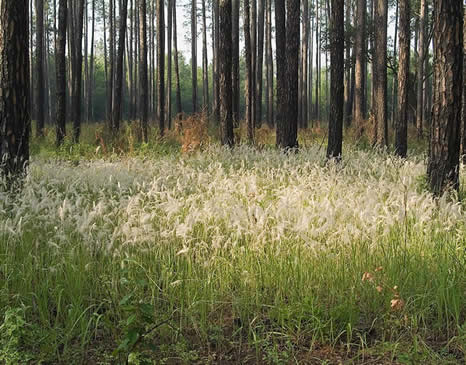Cogongrass is a world-class weed that is invading the South.
By:
James H. MillerThis article is redacted from a presentation included as part of the Proceedings of the Regional Cogongrass Conference in 2007.
 The southern region is in a crisis. Cogongrass (Imperata cylindria) is a world-class invasive grass and a Federally-listed noxious weed that continues to invade more lands and is widely regarded as the worst invasive threat in the Southern U.S. Since its multiple introductions in the early 20th century, it has spread to infest 1 million acres in Florida and tens of thousands of acres in Alabama, Georgia, Louisiana, Mississippi, South Carolina and Texas. Annual spread rates are estimated in the thousands of acres and its tolerance to shade means that infested acreage includes interior forests.
The southern region is in a crisis. Cogongrass (Imperata cylindria) is a world-class invasive grass and a Federally-listed noxious weed that continues to invade more lands and is widely regarded as the worst invasive threat in the Southern U.S. Since its multiple introductions in the early 20th century, it has spread to infest 1 million acres in Florida and tens of thousands of acres in Alabama, Georgia, Louisiana, Mississippi, South Carolina and Texas. Annual spread rates are estimated in the thousands of acres and its tolerance to shade means that infested acreage includes interior forests.
Between 1952 and 1974, cogongrass invaded 850 acres per year in Mobile County to occupy 10,000 acres by 1974. Short distance spread by windblown seed and long distance spread by movement of contaminated pinestraw, vehicles and rhizomes in fill dirt means entry to Tennessee, North Carolina, and Arkansas is imminent. Most of the Eastern U.S. and Pacific Northwest states are considered vulnerable. The outcome of cogongrass occupation on other continents has been devastating and this same trend is underway in the South where cogongrass can eventually cover most uncultivated lands. It will not magically disappear someday without concerted programs to contain and combat it.
Cogongrass forms the most exclusive infestations of all invasive species. Productivity losses to forestry, pasture, and orchards are evident but yet to be documented, while control costs are mounting across land uses, including rights-of-way and municipalities. Vast displacement of native plants and wildlife is underway, and is exasperated by the extreme flammability of the grass. This siege to our lands and their richness and productivity cannot be tolerated without a concerted attempt to stop its spread, and reclaim and secure the future of our lands from this and other invasive species.
It is an era of rapid environmental and ecological change.
The invasion of cogongrass appears facilitated by dynamics in this era of rapid global warming, increased air pollution with higher carbon dioxide levels, human encroachment with wildland fragmentation, and solidifying urbanization with a population indifferent to the land base that supports them. These conditions favor cogongrass invasions. However, a wider understanding of this problem should lead to more problem recognition, unified programs with laws, policies, and funding to counter this invasion.
Cogongrass Impacts:
- Stops or hampers productive use of forest lands, pastures, pecan and other orchards,impacts container crops and right-of-way management and is invading municipalities.
- Is highly flammable and presents a high risk to rural homeowners and firefighters.
- Wildlife habitat is destroyed and hunting privileges denied.
- Recreational value is nonexistent and the natural beauty of our lands is defaced.
- Reduces native species biodiversity, impacts community and ecosystem functions and interferes with ecosystem services.
- Eradication costs vary but exceed $200 per acre and can range much higher.
Cogongrass is part of a bigger invasion in the South that demands both a separate and unified management program. The many major seaports around the Gulf coast combined with a long period of horticultural introductions throughout the region have resulted in multiple plant invasions.

Others are underway in concert with the cogongrass spread. Tallowtree (Triadica sebifera) is spreading upward from the Gulf Coast, from an epicenter near Houston, TX, to currently occupy over 600,000 acres. Japanese climbing fern (Lygodium japonicum) is spreading outward from the coast by spores in wind and contaminated pinestraw and equipment to infest over 200,000 acres. Tropical soda apple (Solanum viarum) was introduced in Florida in the 1990’s and now occupies over 200,000 acres and is spreading rapidly by cattle transport and wildlife. Japanese honeysuckle (Lonicera japonica) and Chinese privet (Ligustrum sinense) are both at pandemic levels across the South exacerbating all control and restoration efforts dealing with cogongrass.
Cogongrass is a “problem of the commons” and we all are impacted and must help.
There have been a few examples of concerted and focused efforts to contain cogongrass in the region. There was an effective eradication program in Georgia by the State APHIS Coordinator, Arthur Miller, in the 90’s. Georgia is again organizing to carry on eradication. Dearl Sanders in Louisiana has directed a State effort for a decade to combat cogongrass in his State. Florida’s Environmental Protection Agency’s Bureau of Invasive Plant Management uses State appropriated funds through an organized program for invasive plant control on “preserve lands”, including cogongrass.
None have been strong enough to stop the persistent spread within any state or across state lines. Presently, grassroots Cogongrass Task Forces are being formed in Georgia, Mississippi, South Carolina, and Louisiana. Still, little State political recognition or leadership has been applied to the problem and funding of programs is lacking.